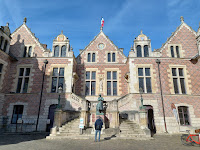Last night I walked the streets of the Orleans old quarter. It is a city of wide avenues and big squares, peaceful and with a sense of space and openness. There is also a sense of money. Old and new seem to be well integrated and almost everything appears to be white: the buildings are white, the pavements are white and the roads are white. It is a beautiful place.
Orleans made its money as one of only a few places with a bridge that crossed the dangerous Loire river. As the one closest to Paris, at a point where the Loire briefly takes a loop northwards, it was also the most strategically important. The city is probably best known for Joan of Arc, who helped rally the French defence of the city in the early 1400s.
I spent the morning visiting the 16th century town hall - beautifully ornate, although now no longer used - and the attractive and cavernous cathedral. Nearby I found a museum in memory of those temporarily sent to internment camps set up in the Orleans area during the Second World War; Orleans was a major rail hub for the Germans, used to take people to the concentration camps in the east. A visit to the house of Joan of Arc was on my list but as it didn’t open until mid afternoon I wandered the Orleans streets for a while, stocked up on food for my trip and returned back to check over the bike.
It turns out that the house of Joan of Arc, a house given to her by a grateful city, has been rebuilt from the shell that remained after the Second World War. All the visit consists of is a fifteen minute animated video about the Maid of Orleans, her visions about the crowning of the King and her battles and eventual capture and burning by the English. All very interesting but not what I had expected.
 |
| Internment Camp Museum |
The evening passed quietly, making the most of the comfort of the little studio flat I am in before getting back on the road tomorrow.






No comments:
Post a Comment